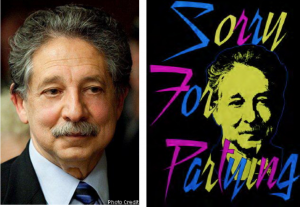“The fair-use privilege … is not designed to protect lazy appropriators.”
I’ve been called a lot of things (including, “lawyer”), but one thing I can be proud of is never having been called a liar.
I’ve been saying that appropriation-for-appropriation’s sake is nothing but pure formalist laziness, pretty much since I was born (evidenced here), and others, like this law review article, have also opined on how the Cariou v. Prince case makes no distinction between the right of copyright holder to “transform” her copyrighted work and a secondary user’s fair use right, upheld by a “transformative” judicial standard. Leave it to a Illinois-based judge to pen identical thoughts.
The case concerns the use of a photo of the Mayor of Madison, Wisconsin on some t-shirts (see pic above), where the photographer sues the appropriator for copyright infringement.
You have to read the entire seven-page opinion not only to get a good dose of judicial analysis, but also get a sense of how damning the 7th Circuit is of the Cariou court. In fact, I would say that the 7th Circuit (reluctantly) stops short of calling the Cariou court “stupid.”
Noting that the “transformative” aspect of a secondary use is not part of the US Copyright Act but rather judge made (by the US Supreme Court, no less), Judge Easterbrook opines, “The Second Circuit has run with the suggestion [of transformativeness] and concluded that ‘transformative’ use is enough to bring a modified copy within the scope of [fair use]. [The] Cariou [Court] applied this to an example of ‘appropriation art,’ in which some of the supposed value comes from the very fact that the work was created by someone else.” (Brackets added)
That thought alone eviscerates the post-modern art-is-holier-than-anything-else dictum that so many in the art-world and some art lawyers love to profess. The author may be dead in MFA and art history programs, but it’s pretty much still alive in the world of law.
Instead, Easterbrook writes, “We think it best to stick with the statutory list, of which the most important usually is the fourth (market effect). We have asked whether the contested use is a complement to the protected work (allowed) rather than a substitute for it (prohibited).”
Read: “We think it’s best to stick to the separation of powers and apply the law, rather than play art critics like the 2nd Circuit and just, you know, make stuff up out of thin air.”
To conclude my rant, Easterbrook and the 7th Circuit find the use of the photo, in this instance, to be fair use. What I want you, keen reader, to keep in mind as you put head-to-pillow tonight, is why the 7th Circuit would go out so far out of its way to criticize the 2nd Circuit. Do you think, keen reader, that perhaps they are welcoming a Cariou v. Prince-like case in the 7th Circuit? Just sayin’.
Tags: appropriation, Art Law, cariou v prince, Copyright, fair use, intellectual property, Judge Easterbrook, second circuit, transform, transformativeness




Easterbrook is right that the Cariou standard is problematic and to return to the market inquiry as the dominant one, but not for the reasons he gives. Rather, because there is no identifiable way to accurately distinguish between transformative and derivative in certain contexts, especially when the physical characteristics overlap, it’s only through examining market substitution that one can identify if a work is derivative or transformative
Easterbrook also gets the design/goal of 107 wrong—it’s not to solve market failure, although that is a byproduct, but as a First Amendment protection.
And that law review article is junk:
“[I]t nevertheless served the same purposes of aesthetic enjoyment and social commentary as the original.”
That’s so broad as to be meaningless. Basically, that identifies all art as statutorily derivative.
Stehphan,
Good points, and true about the First Amendment and 107, but being Easterbrook I think
we can see why he favors the market. But I’d like to hear more about why you think the HLS
article is “junk.”
I’ll say this. Unfortunately there is this post-modern belief that, and as Easterbook also notes,
a different author necessarily means a different meaning. This may have been true in the late ’60s and
’70s, but by now it’s about as radical as an 8-Track. In a sense, if that strategy is true, then yes, what
Prince hopes to accomplish is already there in Cariou’s work. Ironic.
Thoughts?